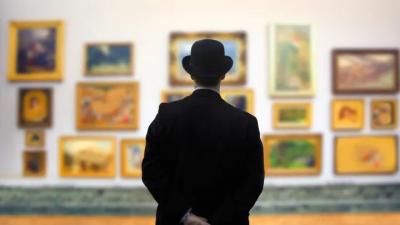Erie Philharmonic Creates Art with Pictures at an Exhibition
Mussorgsky's masterpiece paints sonic scenes
SATURDAY, MAR. 23
The Erie Philharmonic will be taking audiences through a gallery of art and music with their performance of Modest Mussorgsky's Pictures at an Exhibition. Adapted by Maurice Ravel for orchestra, this arrangement contains 10 movements, each describing a scene from a painting. Preceding Ravel's arrangement of Mussorgsky's masterwork will be the return of pianist Simone Dinnerstein, as she performs Johannes Brahms' Piano Concerto No. 2.
"This captivating performance begins with Dinnerstein's interpretation of Brahms' Piano Concerto No. 2. Her mastery of the piano translates each phrase into a poignant story, unfolding against the backdrop of Brahms's rich creative tapestry," the Erie Philharmonic describes. "[Pictures at an Exhibition]'s grandeur and dynamism will be brought to life in full orchestral splendor, revealing each evocative image that Mussorgsky originally drew, offering listeners a multi-sensory experience that is as vivid as it is memorable."
Although Mussorgsky received piano lessons from his mother, his initial career path was not to become a composer. At the age of 13, his parents enrolled him and his brother at the School of Cadets in St. Petersburg in order to restore the family tradition of military service. In 1858, he resigned from his commission at a military hospital to devote himself to music and continued to compose while working as a civil servant. During this time, he composed Night on Bald Mountain, which would be featured in the 1940 Walt Disney animated film Fantasia.
Pictures at an Exhibition was inspired by the artwork of Victor Hartmann, who shared a close friendship with Mussorgsky. After Hartmann's sudden death in 1873, Mussorgsky was inspired by the paintings Hartmann had given him, composing the piece within two weeks in June of 1874. The piano suite would not be published until 1886, five years after Mussorgsky's death. French composer Maurice Ravel was commissioned by Russian conductor Serge Koussevitzky in 1922 to create an arrangement. Koussevitzky was given sole conducting rights for a period of time through the contract with the publishers of the original piano suite and premiered Ravel's arrangement in Paris on Oct. 9, 1922. The first recording of the arrangement was made by the Boston Symphony Orchestra in 1930 under Koussevitzky's direction.
Brahms began work on his second piano concerto in 1878, over 20 years after his first piano concerto premiered in 1858. Unlike many concertos of the Classical and Romantic eras, the composition contained four movements as opposed to three. Dedicated to his piano teacher Eduard Marxsen, the piece premiered on Nov. 9, 1881 with the Budapest Philharmonic Orchestra and Brahms serving as the pianist. It was a critical success, and he would perform the piece often as he toured around Europe.
Dinnerstein, who will be performing the piano concerto, previously joined the Erie Philharmonic in 2018 to premiere Phillip Glass' Piano Concerto No. 3. She has worked with ensembles around the world including the New York Philharmonic, London Symphony Orchestra, the Orchestra Sinfonica Nazionale RAI in Italy, the Seoul Arts Center, the Royal Scottish National Orchestra and the Montreal Symphony Orchestra. In addition, she has performed concerts through the Piatigorsky Foundation and founded the Neighborhood Classics concert series, which raises funds for music education programs in New York City public schools. A graduate of the Juilliard School of Music, she is currently on the piano faculty of the Mannes School of Music in New York City.
8 to 10:30 p.m. // Warner Theatre, 811 State St. // $17-$61 // For tickets and info: eriephil.org


.png)
